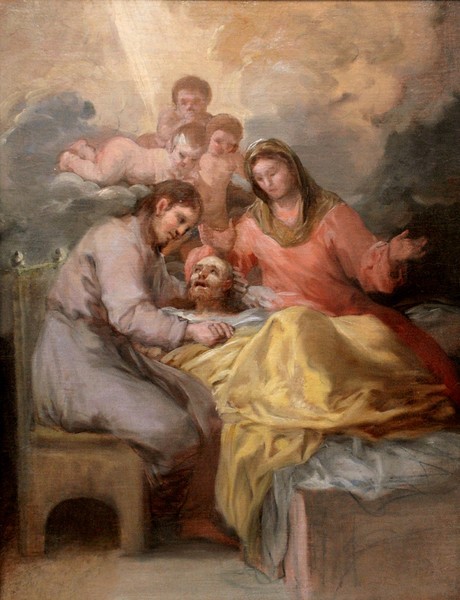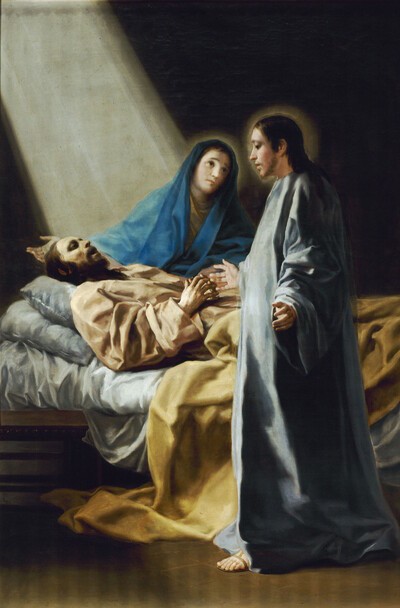- Cronología
- 1787
- Ubicación
- Flint Institute of Arts, Flint, United States
- Dimensiones
- 54.5 x 40.5 cm
- Técnica y soporte
- Oil on canvas
- Reconocimiento de la autoría de Goya
- Documented work
- Titular
- Flint Institute of Arts
- Ficha: realización/revisión
- 18 Jan 2010 / 28 Jun 2023
- Inventario
- (1967.19)
- Otros títulos:
-
Death of Saint Joseph
This work belonged to Aureliano de Beruete y Moret. It then moved to Berlin and the collection of Otto Gerstenberg, who acquired the painting from Beruete's widow in 1929. In 1967 it was bought by the Flint Institute of Arts.
This painting seems to be an initial idea rather than a sketch, a preparatory study which Goya evidently later rejected, given that the composition presented here is very different from that of the final piece. The painting is executed on a light ground and an underlying drawing is clearly visible.
This work is so different from the final painting produced that some academics doubt its authenticity. The most likely scenario is that this first concept was followed by other sketches which are not available to us today. However, as Camón has pointed out, it is beyond doubt that the painting is in fact by Goya, as demonstrated by the free and audacious brushwork so characteristic of Goya's work. This composition is more baroque, and the artist eventually chose to adopt a more classicist style, in harmony with the church where it was to be housed.
The composition has great depth, and the foreshortened bed focuses our gaze on the dying Joseph. The iconography of the work corresponds to representations from the 17th century based on the apocryphal medieval account of the death of Joseph, supposedly related by Jesus and studied by E. Mâle. Saint Joseph lies on the bed with an expression of fear and anguish on his face. He is accompanied by Mary and Jesus, who patiently attend him, comforting the dying man. The humanity of the depiction of Christ is particularly noteworthy. Above the group we can see small angels reminiscent of those who witness the last moments of Saint Francis Xavier in the work Death of Saint Francis Xavier housed in the Museum of Zaragoza.
The so-called "architectural style" which Goya eventually adopted for the final painting located in the monastery in Valladolid, while it is impressive in its solemnity, has lost something of the anguish which Joseph suffers in this initial sketch, and - above all - the tenderness expressed by Jesus towards his putative father.
-
Pinturas de GoyaMuseo Nacional del PradoMadrid1928consultant editor Fernando Álvarez de Sotomayor. From Apri to -May 1928cat. 11/78
-
Goya and his timesThe Royal Academy of ArtsLondon1963cat. 66cat. 65
-
Goya (1746-1828). Peintures-Dessins-GravuresCentre Cultural du MaraisParís1979consultant editors Jacqueline et Maurice Guillardcat. 9
-
Goya and the art of his timeMeadows MuseumDallas1983consultant editor Edward J. Sullivan. From December 7th 1983 to February 6th 1983cat. I.3
-
Goya y el espíritu de la IlustraciónMuseo Nacional del PradoMadrid1988from October 6th to December 18th 1988. Exhibited also at Museum of Fine Arts, Boston, January 18th to March 26th 1989; The Metropolitan Museum of Art, Nueva York, May 9th to July 16th 1989, Madrid curator Manuela B. Mena Marqués, scientific directors Alfonso E. Pérez Sánchez and Eleanor A. Sayrecat. 14
-
Goya. El Capricho y la Invención. Cuadros de gabinete, bocetos y miniaturasMuseo Nacional del PradoMadrid1993from November 18th 1993 to February 15th 1994. Exhibited also at the Royal Academy of Arts, London, March 18th to June 12th 1994 and The Art Institute of Chicago, Chicago, July 16th to October 16th 1994, consultant editors Manuela B. Mena Marqués and Juliet Wilson-Bareaucat. 15
-
Goya: Order and disorderMuseum of Fine ArtsBoston2014cat. 21
-
L'œuvre peint de Goya. 4 volsParís1928-1950vol. I, p. 123, cat. 76
-
Goya. El capricho y la invención. Cuadros de gabinete, bocetos y miniaturasMadridMuseo del Prado1993pp. 142-145, 350, cat. 15 y p. 143 (il.)
-
Goya: Order & DisorderBostonMuseum of Fine Arts Boston Publications2014pp. 60-61

